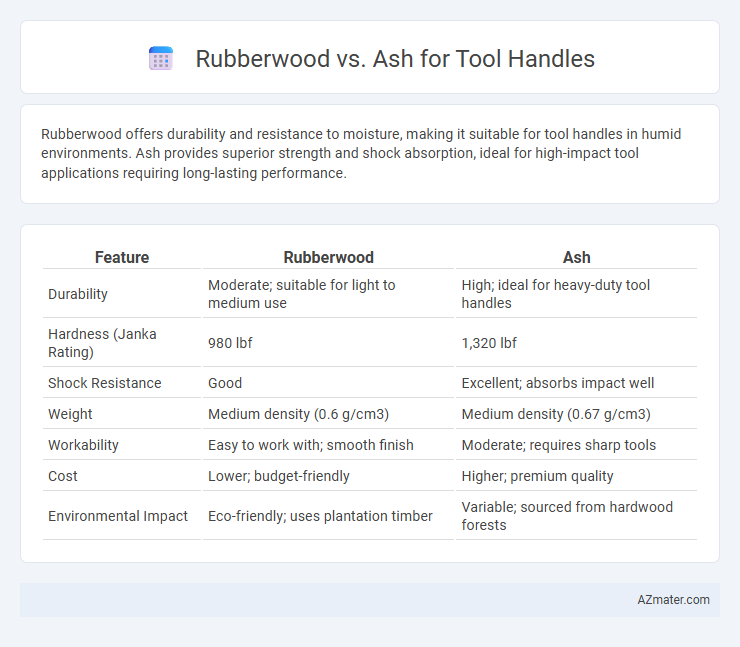Rubberwood offers durability and resistance to moisture, making it suitable for tool handles in humid environments. Ash provides superior strength and shock absorption, ideal for high-impact tool applications requiring long-lasting performance.
Table of Comparison
| Feature | Rubberwood | Ash |
|---|---|---|
| Durability | Moderate; suitable for light to medium use | High; ideal for heavy-duty tool handles |
| Hardness (Janka Rating) | 980 lbf | 1,320 lbf |
| Shock Resistance | Good | Excellent; absorbs impact well |
| Weight | Medium density (0.6 g/cm3) | Medium density (0.67 g/cm3) |
| Workability | Easy to work with; smooth finish | Moderate; requires sharp tools |
| Cost | Lower; budget-friendly | Higher; premium quality |
| Environmental Impact | Eco-friendly; uses plantation timber | Variable; sourced from hardwood forests |
Introduction to Rubberwood and Ash Tool Handles
Rubberwood tool handles offer durability and eco-friendliness, derived from the Para rubber tree, which is widely grown in Southeast Asia and harvested sustainably after latex extraction. Ash wood handles are prized for their strength, shock resistance, and versatility, commonly used in hand tools due to the wood's straight grain and ability to absorb impact. Both materials provide reliable grip and comfort, but Rubberwood is favored for its cost-effectiveness and environmental benefits, while Ash is chosen for heavy-duty applications requiring superior toughness.
Physical Properties Comparison: Rubberwood vs Ash
Rubberwood features a density of approximately 560 kg/m3 with moderate hardness and good shock resistance, making it suitable for lightweight tool handles that require some flexibility. Ash is denser, about 700 kg/m3, with higher hardness and exceptional toughness, providing superior impact resistance and durability for heavy-duty tool handles. The greater stiffness and resilience of ash result in better vibration absorption, enhancing user comfort during prolonged use compared to the more elastic but less robust rubberwood.
Durability and Strength of Rubberwood Handles
Rubberwood handles offer moderate durability and strength, making them suitable for light to medium tool usage but less robust compared to ash. Ash wood is renowned for its exceptional tensile strength and shock resistance, providing superior longevity for heavy-duty tools. Rubberwood handles may wear faster under high stress, while ash maintains structural integrity under rigorous conditions.
Durability and Strength of Ash Handles
Ash tool handles are renowned for their exceptional durability and strength, making them a preferred choice for heavy-duty applications. The dense, shock-absorbent grain structure of ash provides superior resistance to impact and wear compared to rubberwood, which is softer and less resilient. This high strength-to-weight ratio ensures ash handles maintain integrity and performance through prolonged, rigorous use.
Workability and Crafting Differences
Rubberwood offers moderate workability with a fine, straight grain that machines easily, making it suitable for tool handles requiring smooth finishes and consistent shaping. Ash provides superior workability characterized by its open grain, excellent shock resistance, and ease of sanding, allowing craftsmen to create durable, ergonomic handles that withstand heavy use. Crafting with ash often demands less effort due to its consistent texture, whereas rubberwood requires careful finishing to enhance durability and prevent splintering.
Weight and Balance for Tool Comfort
Rubberwood offers a lightweight option with moderate density, contributing to balanced tool handles that reduce user fatigue during extended use. Ash, known for its higher density and strength, provides superior weight distribution and exceptional shock absorption, enhancing control and comfort in heavy-duty tasks. Choosing between rubberwood and ash depends on prioritizing either lighter handling or robust balance for optimal ergonomic tool performance.
Impact Resistance and Shock Absorption
Rubberwood offers moderate impact resistance and excellent shock absorption due to its dense, fibrous structure, making it suitable for tool handles requiring vibration dampening. Ash wood, renowned for its superior toughness and high impact resistance, provides strong durability and effective shock absorption, ideal for heavy-duty tool handles subjected to repeated stress. Comparing the two, ash outperforms rubberwood in impact resistance, while rubberwood excels in minimizing vibration, influencing the choice based on specific tool application needs.
Cost Analysis: Rubberwood vs Ash Handles
Rubberwood handles generally cost less than ash handles due to the abundance and faster growth rate of rubberwood trees, making them a budget-friendly option for tool manufacturing. Ash handles, prized for their durability and impact resistance, command a higher price but often provide better long-term value and performance. When conducting a cost analysis, the initial savings on rubberwood must be weighed against ash's superior strength and longevity in tool handle applications.
Environmental Sustainability and Sourcing
Rubberwood, sourced from parenchyma cells in rubber trees after latex harvesting, offers superior environmental sustainability due to its use of plantation-grown timber otherwise considered waste, minimizing deforestation impact and promoting recycling. Ash, derived from hardwood trees predominantly found in North America and Europe, involves slower growth and higher carbon footprint due to longer maturation periods and responsible forestry practices, impacting overall sustainability. Choosing rubberwood for tool handles supports sustainable material sourcing by leveraging fast-regenerating, economically viable plantation resources, contrasting with ash's traditional but less eco-efficient supply chain.
Best Applications for Rubberwood and Ash Handles
Rubberwood handles are best suited for light to medium-duty tools due to their fine grain and smooth finish, offering comfort and durability in household or gardening tools. Ash handles excel in heavy-duty applications requiring shock absorption and strength, making them ideal for hammers, axes, and other striking tools. Both woods provide excellent grip, but Ash's flexibility and resilience make it preferred for high-impact tool handles.

Infographic: Rubberwood vs Ash for Tool Handle
 azmater.com
azmater.com